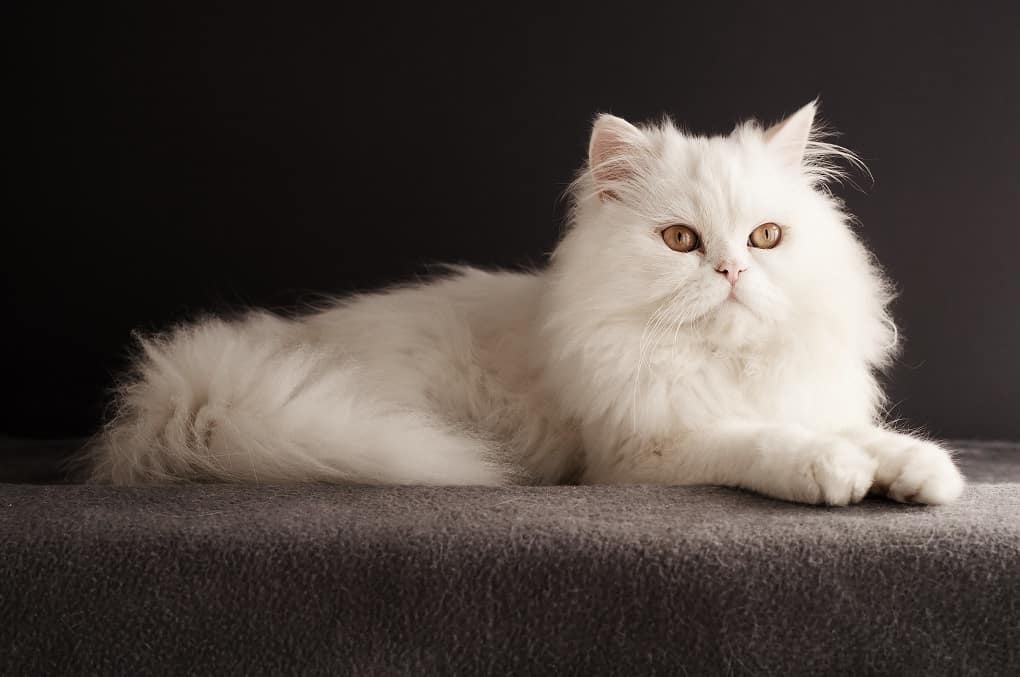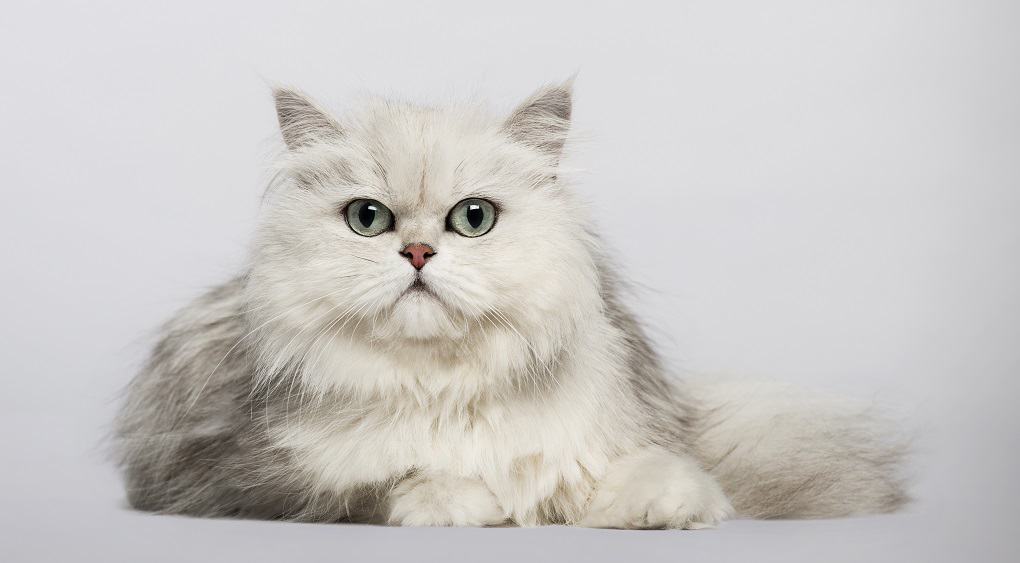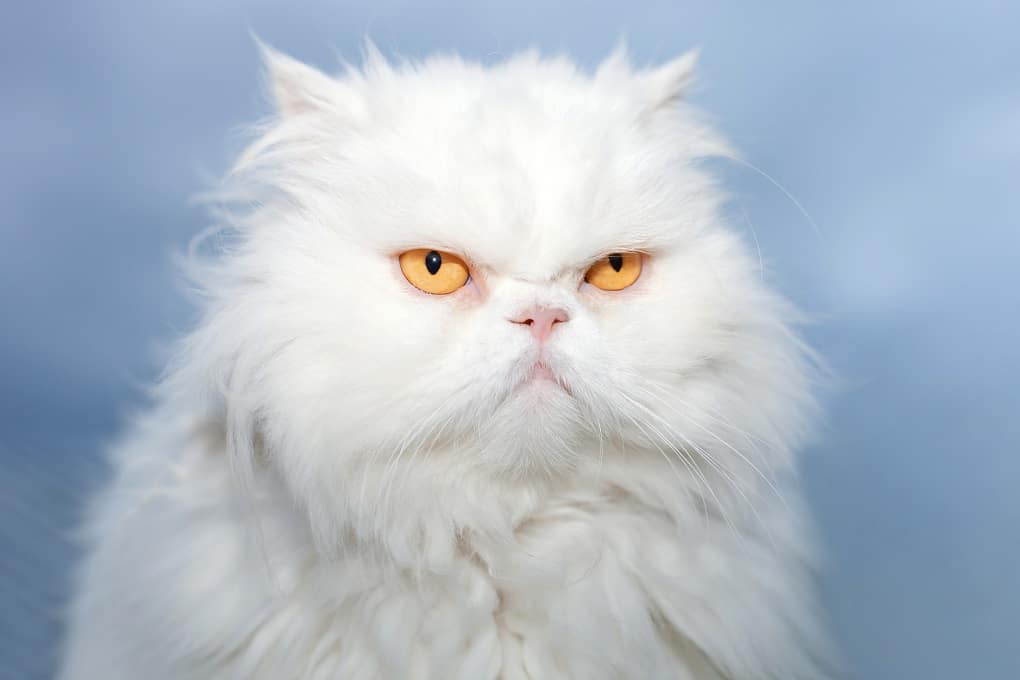Table of Contents

If you are looking for a cat that has a wonderful temperament, that is beautiful, and that is unique in appearance, you may just be looking for a Persian cat.
This is the most popular breed of cat in North America, and perhaps the world, and first became popular during the Victorian era, but it has been around for much longer than that.
Not much is known about the early history of the Persian cat, but one thing we do know is that it is beautiful, and makes a wonderful family pet.
Origin and history of the breed

So, what is the origin of the Persian? As mentioned in the introduction, little is known about the earliest history of the breed, but we do have a bit of history on this cat, nonetheless. For instance, they are thought to have originated in Persia.
Persians became popular in Victorian Britain, and were among the pets at Britain’s first cat shows. They have been bred to have a short face, a round head, a flat nose, chubby cheeks, and a short, squat body. Throughout the decades, these features have become quite exaggerated, which is why we now have two types of Persians – Traditional and Show.
Physical standards of the breed
There are different standards for Show and Traditional Persians. The Show Persian has a head that is rounded with a thick mane or ruff, a flat nose, large, round eyes, small ears, a short, squat body with short legs, and a fluffy tail.
Traditional Persians don’t have the same extreme features as their Show counterparts, and have a nose that is a regular length. Both are long-haired with fluffy tails, and can come in a variety of colors and patterns.
Health and possible diseases
Any pet can be prone to genetic health issues, just as people, and it is no different with Persian cats.
Never buy from any breeder who tells you that their cats are not prone to any health problems, because this is just not the case, and they are just doing what they can to sell their cats. Make sure that you are offered a health guarantee, whether you are buying a Traditional or a Show Persian.
There are hereditary health problems that Persians are known for, including polycystic kidney disease, progressive retinal atrophy, hypertrophic cardiomyopathy, bladder stones, cystitis, and liver shunts. They can also have sinus issues.
Height and size
Persian cats tend to be short and squat. They are not tall cats, and they have roundish bodies. Garfield the cat comes to mind when thinking about the appearance of a Persian cat. Generally, a Persian cat will stand less than 12 inches tall.
The size of a Persian cat goes back to height and weight. Again, your cat should way 10 to 15 pounds, and ideally it will be short and squat.
They do have rounded bodies, so they tend to look larger than they actually are, especially when you add that long fur to the mix. They are an ideal lap cat, and have the affectionate personality to go with their beauty.
Weight
Weight can be a huge problem with Persian cats, so it is important to make sure that you are feeding yours a healthy, well-balanced diet. A healthy cat should weigh around 10 pounds, give or take a pound or two.
If you have a Persian weighing more than 15 pounds and that doesn’t have a large build, it is time to put them on a diet.
Activeness
A Persian cat is perfectly content to sit and relax, particularly on someone’s lap. But, this isn’t to say that they don’t love playing. In fact, they are very playful, and quite curious.
They don’t tend to jump or climb, and they do prefer an environment that is predictable since they don’t adapt well to change. They love to pose and look gorgeous, and when finished, they will grab their favorite toys and have a ball (pun intended).
Hypoallergenic
Let’s be real here for a minute. If you are looking for a hypoallergenic pet, a cat is definitely not the best choice for you, especially a Persian cat.
These are long-haired cats, and they are going to have allergens in their fur. But, this doesn’t mean that someone with pet allergies can’t have a Persian cat; they just need to be more diligent when it comes to grooming.
Lifespan
Persian cats have a typical cat life span of 10 to 15 years. Unfortunately, for most of us, this isn’t nearly long enough to have our beloved pets.
Some Persians have been known to live much longer. Some ways to achieve a long life span are a healthy diet, plenty of physical activity, love, and never let them outdoors unattended.
Caring Difficulty
When it comes to any long-haired cat, there is going to be more involved in the care than with short hairs. This is true of the Persian, who needs regular grooming, particularly brushing. In fact, it is a good idea to get into the habit of brushing your Persian at least once daily.
Other than that, there isn’t much difference in the care of a Persian than with any other cat. They need healthy diets, plenty of exercise, and regular vet visits to make sure they are in good health.
Where to get a Persian Cats
Most people choose to go to a breeder when they want any type of pedigreed cat, including a Persian. When it comes to choosing a breeder, you need to really do your homework.
First, study up on the breed itself, and then study up on the various breeders you are considering. You will want to know the history of the animal, and make sure the breeder has proper health certifications to screen out genetic problems.
Another option is to visit your local shelter. You may not always be able to find a Persian there, but you never know when you may, so it is an option to always consider. In fact, many Persian kittens, both pedigreed and mixed breeds, end up in shelters for any number of reasons.
Talk to local pet organizations, including the SPCA and Carma, and let them know you are looking for a Persian so they can contact you if they come across one.
How much does a Persian Cat cost?
Any pedigreed cat is going to cost a lot of money, but if it is something you really love, it is truly worth it. In the case of a Persian, the price can range from $1,000 to $1,500 for a Traditional.
The price could go a lot higher for a Show Persian, especially if it has already won ribbons.
Choosing the right type of Persian Cat
As we have mentioned, there are two main types of Persians, Traditional and Show.
The type you choose depends on your own personal preferences. For instance, you may prefer the snub nose of the Show over the longer nose on the Traditional.
Both will be extremely fluffy, and have pretty much the same body shape. The best way to choose a cat is to let it choose you – you will know when you have found the right one.
Responsibilities to consider in the care of a Persian Cat
With any pet, there are going to be certain responsibilities, including vet care, a proper diet, and exercise. There are other things to consider with Persian cats.
They are known to have some genetic health problems, and you may end up taking a Persian to the vet more often than you would another type of cat. You will have this pet for many years to come, so consider all of the responsibilities carefully before making your purchase.
What do they require?
All cats require the same things: a comfortable bed (often you), healthy food, water, and proper vet care. They also need lots of love and affection, and plenty of playtime and exercise.
The Persian is no different. But, they may also need additional vet care for their health issues.
Do they need a certain level of care and attention?
All cats need a certain level of care and attention, especially Persian cats. Persians need extra grooming, and love to get plenty of attention.
Make sure that when buying a Persian cat that you are fully prepared for the care and attention it is going to need.
Characteristics of Persian Cats

Here are a few of the main characteristics of Persian cats.
Behavior
These are docile cats that love to cuddle and won’t destroy your home.
Pattern
These cats are available in a variety of colors and patterns.
Affectionate
Persians are ideal for those looking for lap cats.
Dog/child-friendly
Persians get along with most other cats, unless the cats bother them first. When it comes to getting along with dogs, it usually depends on the dog.
Intelligence
Persians are very intelligent cats that can be easily trained.
Energy
Persians prefer to laze around, but they do love to break out and play quite often.
Maintenance
There is more maintenance with a Persian, due to their long coats that need regular brushing.
Types of Persian Cats
There are two main types of Persian cats: the Traditional Persian and the Show Persian. The Traditional is also often referred to as a “doll face” Persian, and it doesn’t have the extreme features that you would see in a Show Persian.
Here’s a short video about how to identify types of Persian cats:
The Traditional Persian tends to have a longer nose, and is somewhat more affectionate than the Show Persian. Within the Show Persian cats, there are several divisions. These include solid, silver and golden, smoke and shaded, tabby, parti-color, bicolor, and Himalayan.
Persians vs. Exotic Shorthair Cats
Maybe you like that punched-in face that the Persian has, but you don’t want the long hair that needs almost constant brushing. If this is the case, you may be interested in an Exotic Shorthair.
These have the short, stubby noses like a Persian, but they also have short coats, so they don’t need nearly as much grooming.
Conclusion
If you want a cat that loves to be cuddled, and is just as beautiful as it is friendly, a Persian is an excellent choice for you. These gorgeous cats are great family pets, and they tend to get along with other pets well.
This is a great addition to any pet-loving family.